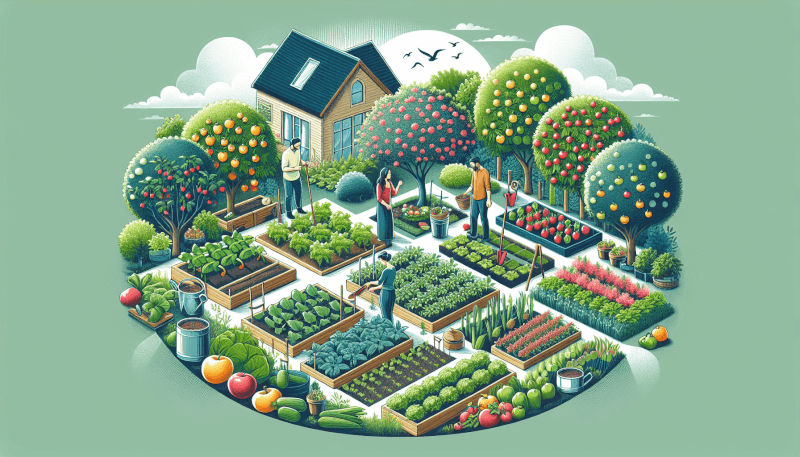Imagine stepping outside your door and picking fresh, organic vegetables and fruits straight from your own garden to create delicious, nutritious meals. With a permaculture garden, this dream can become a reality. By combining sustainable gardening practices with the principles of permaculture, you can create a thriving ecosystem that provides an abundance of healthy ingredients for your recipes. In this article, we will explore the essential steps and techniques to help you design and create your own permaculture garden, ensuring a sustainable and bountiful source of ingredients for your culinary adventures.

Choosing the Right Location for Your Permaculture Garden
Considering Climate and Sunlight
When choosing the location for your permaculture garden, it is important to take into consideration the climate and sunlight conditions of your area. Different plants thrive in different climates, so it is important to choose plants that are suitable for your specific climate. Additionally, sunlight availability is crucial for the proper growth and development of plants. Most vegetables and fruits require at least 6-8 hours of direct sunlight each day, so make sure to choose a location that receives adequate sunlight.
Assessing Soil Quality
The quality of the soil in your chosen location plays a vital role in the success of your permaculture garden. Take the time to assess the soil quality by testing its texture, structure, and fertility. Sandy soil drains quickly and may require additional organic matter to improve water retention, while clay soil tends to hold water and may benefit from amendments to improve drainage. Additionally, it is important to check the pH level of your soil, as different plants thrive in different pH levels. Conduct a soil test and amend the soil as needed to create a suitable growing environment for your plants.
Taking into Account Water Availability
Water is a precious resource, and ensuring that your permaculture garden has access to an adequate water supply is crucial. Consider the availability of water in your chosen location and plan accordingly. If you have access to a reliable water source, such as a well or municipal water, you may choose to install an efficient irrigation system to ensure that your plants receive adequate water. If water availability is limited, consider implementing water conservation strategies such as rainwater harvesting or utilizing water-efficient techniques like swales and mulch basins.
Designing Your Permaculture Garden Layout
Zone and Sector Planning
Zone and sector planning is a key aspect of permaculture garden design. By dividing your garden into different zones based on their proximity to your house and the frequency of use, you can create a more efficient and functional layout. Zone 1, located nearest to your house, is where you should place plants that require frequent care and attention, such as herbs and salad greens. Zone 2 can include larger crops like fruits and vegetables, while Zone 3 can be reserved for trees and larger perennials. Zone 4 is a semi-wild area where nature is allowed to flourish, and Zone 5 is left completely undisturbed.
Plant Guilds and Polycultures
Plant guilds and polycultures involve planting a diverse range of plants that work together to create a mutually beneficial ecosystem. By selecting plant combinations that complement each other’s growth patterns, nutrient needs, and pest resistance, you can create a more resilient and productive garden. For example, planting nitrogen-fixing plants like legumes alongside heavy feeders like tomatoes can help improve soil fertility and reduce the need for synthetic fertilizers.
Utilizing Vertical Space
In a permaculture garden, utilizing vertical space is a great way to maximize yield without taking up excessive ground space. Consider incorporating trellises, arbors, or fences to support vining plants such as cucumbers, beans, or grapes. This not only helps to optimize space but also creates a visually appealing garden. Additionally, vertical gardening allows for better air circulation and can help reduce the risk of disease in your plants.
Selecting Plants for Your Permaculture Garden
Choosing Native and Adapted Species
When selecting plants for your permaculture garden, opt for native and adapted species that are well-suited to your climate and soil conditions. Native plants have adapted to the local environment and are generally more resistant to pests and diseases. They also require less maintenance and are more likely to thrive in your garden. Adapted species, on the other hand, are non-natives that have proven to be well-suited to your specific region’s conditions. By choosing these types of plants, you can create a garden that is both sustainable and resilient.
Emphasizing Perennial and Self-seeding Plants
Perennial plants are a great addition to a permaculture garden as they come back year after year, reducing the need for replanting. Additionally, self-seeding plants can save both time and effort as they naturally produce offspring that will grow in subsequent seasons. Incorporating a variety of perennial and self-seeding plants can create a self-sustaining ecosystem in your garden.
Incorporating Edible Plants and Herbs
An essential aspect of a permaculture garden is incorporating edible plants and herbs. This not only provides you with a sustainable source of fresh food but also enhances the biodiversity and functionality of your garden. Consider planting a variety of fruits, vegetables, and herbs that you enjoy consuming. By having a diverse range of edible plants, you can create a vibrant and productive garden that meets both your culinary and permaculture goals.
Building and Maintaining Healthy Soil
Composting and Vermicomposting
Composting is a natural and effective way to build healthy soil. By collecting kitchen scraps, yard waste, and other organic materials, you can create nutrient-rich compost that enriches the soil and improves its structure. Vermicomposting, which involves the use of worms, can be an additional technique to break down organic matter quickly and generate nutrient-dense worm castings. Both composting and vermicomposting are environmentally-friendly methods that reduce waste and provide valuable nutrients to your plants.
Sheet Mulching
Sheet mulching, also known as lasagna gardening, is an effective technique to improve soil health and suppress weeds. It involves layering organic materials, such as leaves, lawn clippings, compost, and cardboard, on top of the soil. This creates a natural mulch that retains moisture, adds organic matter, and breaks down over time, enriching the soil below. Sheet mulching not only improves soil fertility but also helps to conserve water and reduce the need for chemical fertilizers or herbicides.
Applying Organic Matter
Adding organic matter to your soil is crucial for building and maintaining healthy soil. This can be done by incorporating compost, well-rotted manure, or other organic materials into the soil. Organic matter improves soil structure, enhances water retention, and provides essential nutrients for plant growth. By regularly adding organic matter to your garden, you can create a thriving ecosystem that supports the health and vitality of your plants.

Capturing and Conserving Water in Your Permaculture Garden
Installing Rainwater Harvesting Systems
Harvesting rainwater is an excellent way to conserve water and make the most of natural resources. By installing rainwater harvesting systems, such as rain barrels or larger storage tanks, you can capture rainwater from your roof and use it to irrigate your permaculture garden. Implementing a filtration system can ensure that the collected rainwater is safe for use on your plants.
Designing Swales and Keyline Watering
Swales are shallow ditches or trenches designed to capture and distribute water across the landscape. When properly designed, they help to slow down and infiltrate water, preventing erosion and allowing it to penetrate deep into the soil. Keyline watering, on the other hand, is a technique that involves the use of contour lines to guide water flow and maximize its absorption into the soil. By incorporating swales and keyline watering into your permaculture garden, you can effectively manage water runoff and increase water availability for your plants.
Mulching and Mulch Basins
Mulching is an essential practice in a permaculture garden that helps conserve water and suppress weeds. By covering the soil with a layer of organic or inorganic mulch, such as wood chips or straw, you can reduce evaporation, retain moisture, and regulate soil temperature. Mulch basins, which involve creating depressions around the base of plants and filling them with mulch, can further help to capture and store water, ensuring that it reaches the plant’s roots where it is needed most.
Promoting Natural Pest Control and Beneficial Insects
Creating Habitats for Beneficial Insects
Beneficial insects play a vital role in maintaining a balanced ecosystem and controlling pests in your permaculture garden. By creating habitats that attract and support these beneficial insects, such as ladybugs, lacewings, and bees, you can naturally control pest populations. Planting a variety of native flowering plants, herbs, and providing shelter like bee hotels or birdhouses can help create a diverse and welcoming environment for these helpful insects.
Attracting Birds and Bats
Birds and bats are also excellent natural pest control agents as they feed on insects and help keep pest populations in check. By providing food sources, nesting sites, and water sources in your permaculture garden, you can attract these beneficial creatures and encourage them to make your garden their home. Bird feeders, bird baths, and bat houses are great additions to create a welcoming habitat for these natural pest predators.
Integrating Companion Planting
Companion planting involves strategically planting different crops together to enhance their growth and deter pests. Some plants have natural repellent properties that can help protect neighboring plants from pests. For example, planting marigolds alongside tomatoes can deter aphids, while planting basil near cabbage can help repel cabbage moths. By integrating companion planting techniques, you can naturally reduce the need for chemical pesticides and create a harmonious garden ecosystem.

Implementing Energy-Efficient and Sustainable Garden Features
Using Renewable Energy Sources
Incorporating renewable energy sources into your permaculture garden can help reduce your environmental footprint and save on energy costs. Consider installing solar panels to power garden equipment, lighting, or irrigation systems. Utilizing solar energy not only reduces reliance on traditional energy sources but also contributes to a more sustainable and self-sufficient garden.
Designing Passive Solar Structures
Passive solar design involves using the sun’s energy to heat, cool, and illuminate your garden structures. By designing structures such as greenhouses, cold frames, or even pergolas with consideration to the angle of the sun, you can optimize natural light and temperature control. This can help extend the growing season, protect delicate plants from harsh weather conditions, and reduce the need for artificial lighting or heating.
Applying Efficient Irrigation Systems
Efficient irrigation systems are crucial in a permaculture garden to ensure that water is used effectively and not wasted. Drip irrigation, for example, delivers water directly to the plant’s roots, reducing evaporation and water loss compared to overhead sprinklers. Rain sensors or soil moisture sensors can also be integrated into your irrigation system to prevent overwatering and conserve water. By implementing efficient irrigation systems, you can minimize water usage and create a more sustainable garden.
Managing Weeds, Pests, and Diseases Organically
Mulching and Ground Covering
Mulching not only conserves water but also helps suppress weeds by providing a barrier between the soil and sunlight, preventing weed growth. Additionally, planting ground cover plants, such as clover or creeping thyme, can help smother weeds by outcompeting them for nutrients and light. By employing these organic weed management strategies, you can reduce the need for herbicides and create a healthier garden environment.
Introducing Natural Predators
Introducing natural predators into your permaculture garden is an effective way to control pests organically. Ladybugs, lacewings, and praying mantises are just a few examples of beneficial insects that prey on common garden pests. Additionally, attracting small birds or using insect-repelling plants like citronella can help deter pests. By encouraging a diverse range of natural predators, you can maintain a balance in your garden and reduce the need for chemical pesticides.
Using Homemade Pest Repellents
Homemade pest repellents can be effective in deterring pests without the use of harsh chemicals. For example, a mixture of garlic, onion, and pepper can be blended with water to create a natural insect repellent. Spraying this solution onto plants can help deter pests such as aphids or caterpillars. Additionally, planting herbs like mint, rosemary, or lavender can help repel pests due to their strong scents. By utilizing these natural pest repellents, you can minimize the impact of pests on your garden while promoting a safe and healthy environment.

Harvesting and Storing Your Garden Produce
Identifying Optimal Harvest Times
Knowing when to harvest your fruits and vegetables is essential to ensure optimal flavor and quality. Different crops have specific signs to look for when they are ready to be harvested. For example, tomatoes are best harvested when they are fully mature and have reached their full color, while leafy greens like lettuce should be harvested when they are young and tender. Familiarize yourself with the harvesting requirements of each crop in your permaculture garden to ensure you pick them at their peak.
Properly Washing and Curing Vegetables
After harvesting your garden produce, it is important to properly wash and cure them to maintain their freshness and longevity. Vegetables should be gently rinsed to remove any dirt or debris and allowed to dry before storing. Curing is the process of allowing certain vegetables, such as onions and garlic, to dry in a well-ventilated area to enhance their flavor and extend their shelf life. By following proper washing and curing techniques, you can enjoy your homegrown produce for longer periods.
Storing Food in a Root Cellar
A root cellar is a traditional method of storing fruits and vegetables in a cool, dark, and humid environment. This technique allows you to store produce for extended periods, sometimes even throughout the winter. Root cellars can be built underground or in a basement and provide the ideal conditions for preserving the freshness and nutritional value of your garden produce. By utilizing a root cellar, you can reduce food waste and enjoy the fruits of your labor all year round.
Creating Sustainable and Healthy Recipes from Your Permaculture Garden
Exploring Seasonal and Local Produce
One of the joys of a permaculture garden is being able to cook with fresh, seasonal produce. Take advantage of the variety of fruits and vegetables available in each season and experiment with recipes that highlight their flavors. By incorporating seasonal and local produce into your cooking, you not only support local farmers but also reduce the carbon footprint associated with long-distance transportation of food.
Experimenting with Unique Vegetable Varieties
Permaculture gardens often offer the opportunity to grow unique and heirloom vegetable varieties that may not be readily available in stores. Take advantage of this diversity and experiment with different varieties in your recipes. For example, purple carrots, striped tomatoes, or white eggplants can add a unique twist to your meals. By exploring these unique vegetable varieties, you can create exciting and flavorful dishes that are sure to impress.
Incorporating Herbs and Spices
Herbs and spices are essential ingredients in any permaculture garden, as they add flavor and depth to your dishes. Experiment with different herbs and spices from your garden to enhance the taste of your recipes. Freshly picked basil, rosemary, or cilantro can elevate the flavors of your savory dishes, while mint, lemon balm, or lavender can add a refreshing twist to desserts or beverages. By incorporating a variety of herbs and spices, you can create sustainable and healthy recipes that are bursting with flavor.
In conclusion, creating a permaculture garden requires careful consideration of factors such as climate, soil quality, water availability, and plant selection. By implementing sustainable practices like composting, rainwater harvesting, natural pest control, and efficient irrigation, you can create a thriving and productive garden. Harvesting and storing your garden produce properly allows you to enjoy the fruits of your labor year-round. Finally, experimenting with seasonal produce and incorporating herbs and spices from your garden into your recipes can elevate your culinary creations to new heights. Start your permaculture journey and enjoy the benefits of sustainable gardening and healthy eating.



